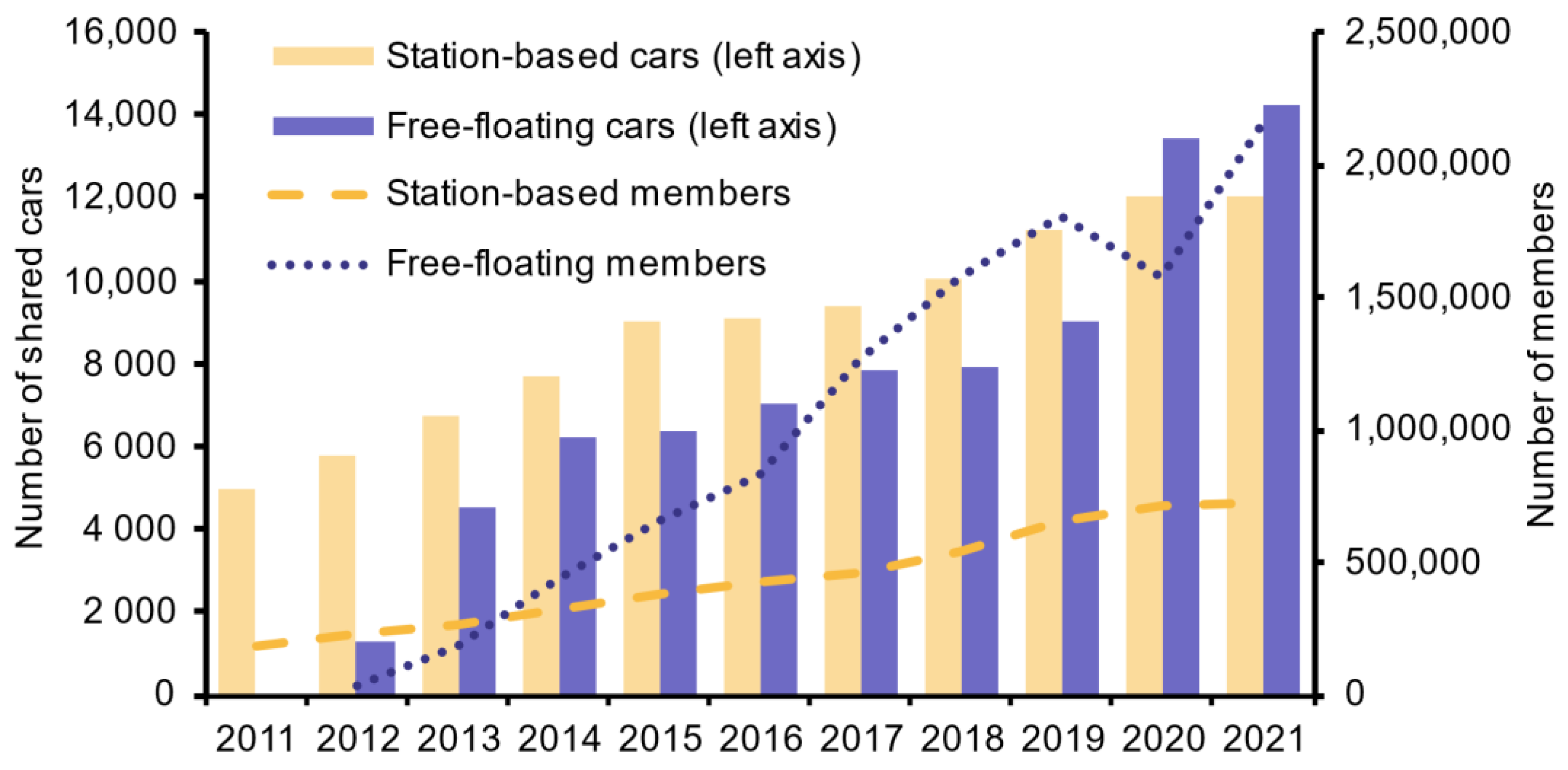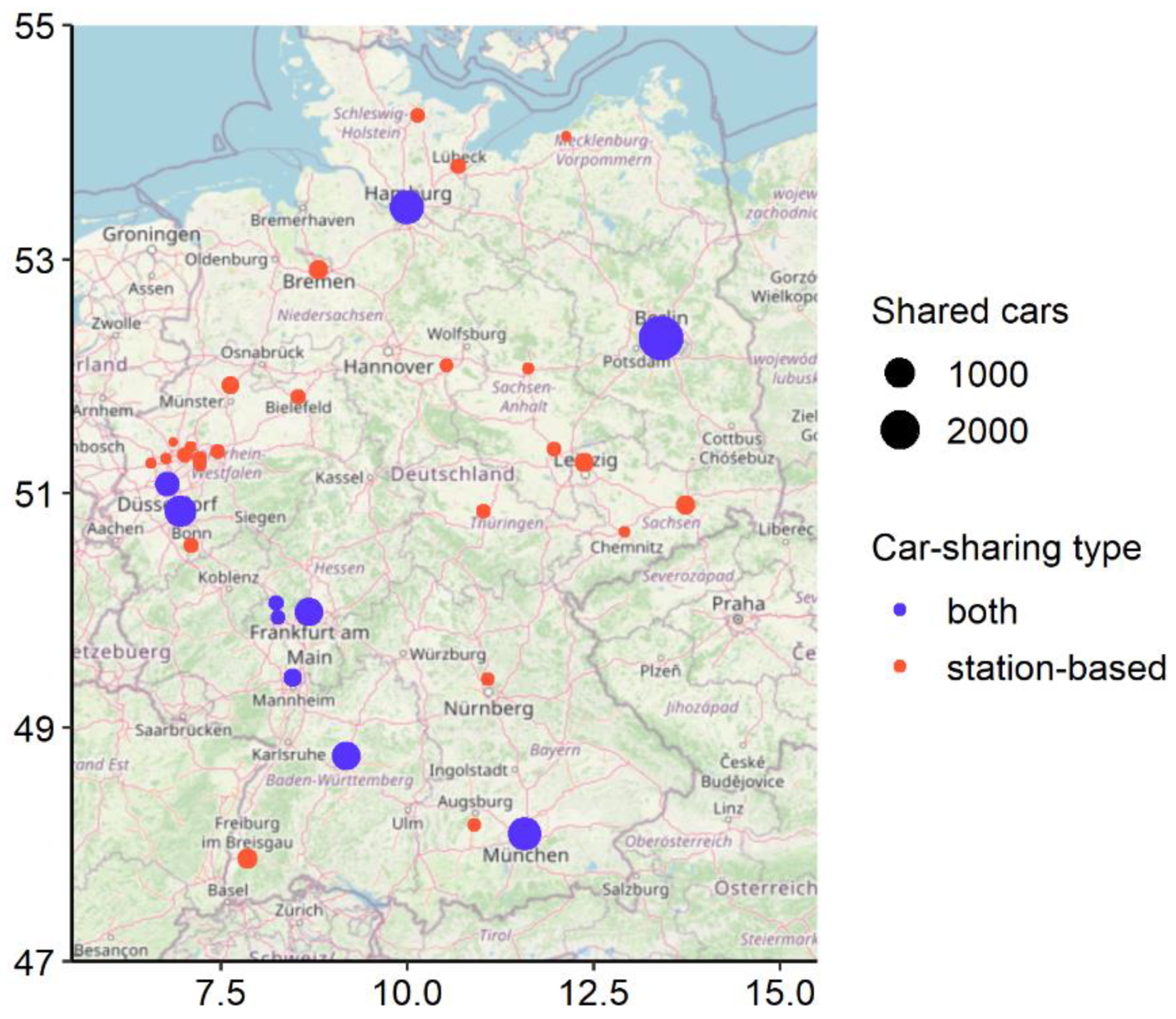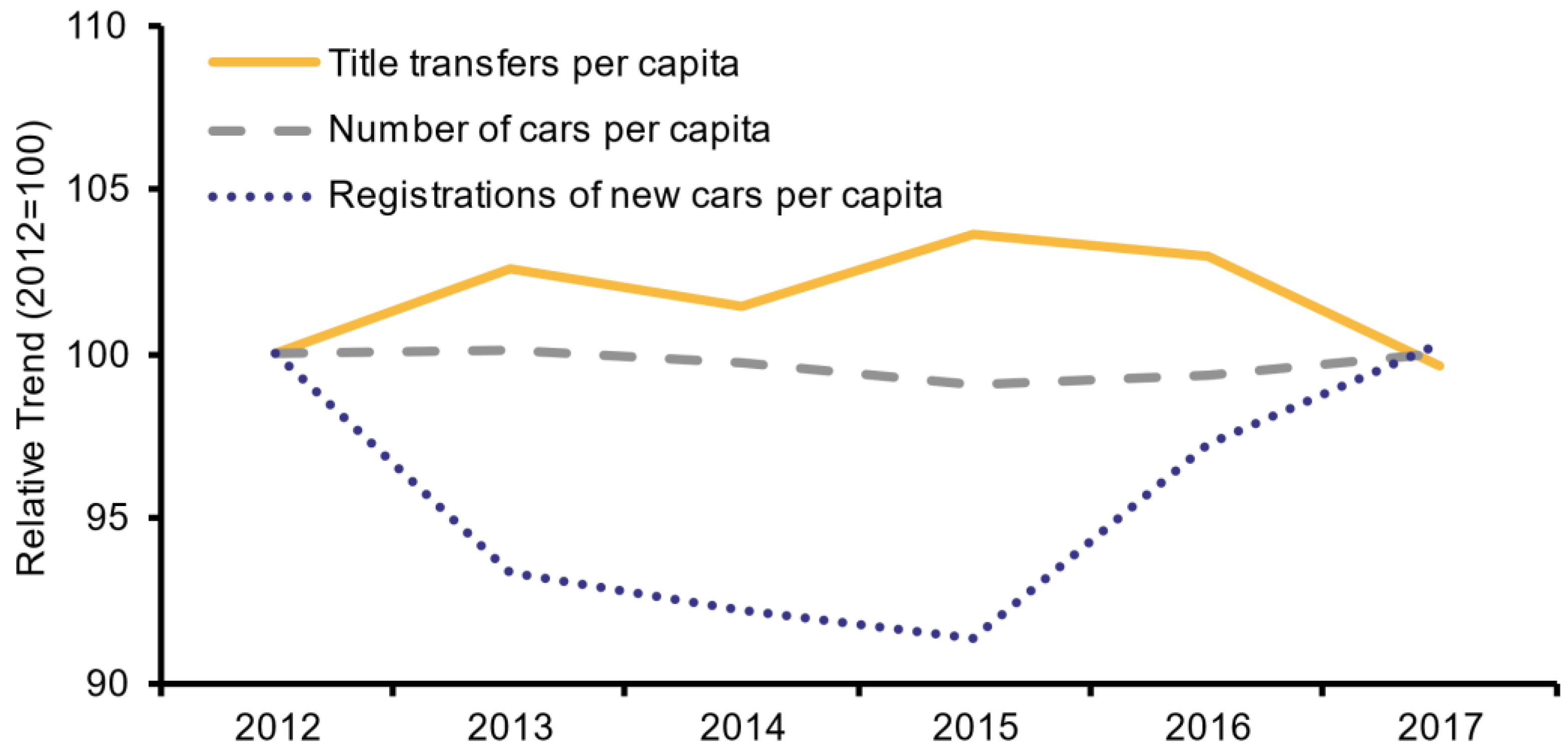Does Car-Sharing Reduce Car Ownership? Empirical Evidence from Germany
Abstract
:1. Introduction
2. Literature
2.1. The Sharing Economy and Its Impacts
2.2. Car-Sharing in Germany
2.3. Station-Based Car-Sharing
2.4. Differences between Station-Based and Free-Floating Car-Sharing
3. Materials and Methods
3.1. Data Origin of the Dependent Variables (Number of Cars)
3.2. Data Origin of the Controls
3.3. Empirical Strategy
- 1.1
- registrations of (privately owned) new cars;
- 1.2
- title transfers from companies to private owners within the city;
- 1.3
- title transfers due to imports from outside the city;
- 1.4
- registrations of cars in the city because of relocation (without changes in ownership).
- 2.1
- scrapping, suspension, and abandoning of (privately owned) cars;
- 2.2
- title transfers from private persons to companies within the city;
- 2.3
- title transfers due to out-of-town exports;
- 2.4
- suspensions of cars because of relocation (without changes in ownership).
- 3.1
- title transfers within the city between private owners.
4. Results
4.1. Summary Statistics
4.2. Number of Private Cars
4.3. Registrations of New and Used Cars
5. Discussion and Conclusions
Funding
Data Availability Statement
Conflicts of Interest
References
- Shaheen, S.A.; Cohen, A.P. Carsharing and Personal Vehicle Services: Worldwide Market Developments and Emerging Trends. Int. J. Sustain. Transp. 2013, 7, 5–34. [Google Scholar] [CrossRef]
- Martin, E.; Shaheen, S.A.; Lidicker, J. Impact of Carsharing on Household Vehicle Holdings: Results from North American Shared-Use Vehicle Survey. Transp. Res. Rec. 2010, 2143, 150–158. [Google Scholar] [CrossRef]
- Cervero, R.; Tsai, Y. City CarShare in San Francisco, California: Second-Year Travel Demand and Car Ownership Impacts. Transp. Res. Rec. 2004, 1887, 117–127. [Google Scholar] [CrossRef]
- Lane, C. PhillyCarShare: First-Year Social and Mobility Impacts of Carsharing in Philadelphia, Pennsylvania. Transp. Res. Rec. 2005, 1927, 158–166. [Google Scholar] [CrossRef]
- Le Vine, S.; Lee-Gosselin, M.; Sivakumar, A.; Polak, J. A New Approach to Predict the Market and Impacts of Round-Trip and Point-to-Point Carsharing Systems: Case Study of London. Transp. Res. D Transp. Environ. 2014, 32, 218–229. [Google Scholar] [CrossRef]
- Becker, H.; Ciari, F.; Axhausen, K.W. Measuring the Car Ownership Impact of Free-Floating Car-Sharing—A Case Study in Basel, Switzerland. Transp. Res. D Transp. Environ. 2018, 65, 51–62. [Google Scholar] [CrossRef] [Green Version]
- Namazu, M.; Dowlatabadi, H. Vehicle Ownership Reduction: A Comparison of One-Way and Two-Way Carsharing Systems. Transp. Policy 2018, 64, 38–50. [Google Scholar] [CrossRef]
- Zervas, G.; Proserpio, D.; Byers, J.W. The Rise of the Sharing Economy: Estimating the Impact of Airbnb on the Hotel Industry. J. Mark. Res. 2017, 54, 687–705. [Google Scholar] [CrossRef] [Green Version]
- Dann, D.; Teubner, T.; Weinhardt, C. Poster Child and Guinea Pig—Insights from a Structured Literature Review on Airbnb. Int. J. Contemp. Hospit. Manag. 2018, 31, 427–473. [Google Scholar] [CrossRef]
- Barron, K.; Kung, E.; Proserpio, D. The Effect of Home-Sharing on House Prices and Rents: Evidence from Airbnb. Mark. Sci. 2021, 40, 23–47. [Google Scholar] [CrossRef]
- Xu, Y.-H.; Pennington-Gray, L.; Kim, J. The Sharing Economy: A Geographically Weighted Regression Approach to Examine Crime and the Shared Lodging Sector. J. Travel Res. 2019, 58, 1193–1208. [Google Scholar] [CrossRef]
- Roma, P.; Panniello, U.; Lo Nigro, G. Sharing Economy and Incumbents’ Pricing Strategy: The Impact of Airbnb on the Hospitality Industry. Int. J. Prod. Econ. 2019, 214, 17–29. [Google Scholar] [CrossRef]
- Burtch, G.; Carnahan, S.; Greenwood, B.N. Can You Gig It? An Empirical Examination of the Gig Economy and Entrepreneurial Activity. Manag. Sci. 2018, 64, 5497–5520. [Google Scholar] [CrossRef] [Green Version]
- Li, Z.; Hong, Y.; Zhang, Z. An Empirical Analysis of On-Demand Ride Sharing and Traffic Congestion. In Proceedings of the 2016 International Conference on Information Systems (ICIS 2016), Dublin, Ireland, 11–14 December 2016. [Google Scholar]
- Heise Autos Car2go: Pkw-Spontanmiete Jetzt Auch in Hamburg. Available online: https://heise.de/-1223807 (accessed on 27 August 2019).
- Datenblatt CarSharing in Deutschland. Available online: https://carsharing.de/sites/default/files/uploads/datenblatt_carsharing_in_deutschland_stand_01.01.2021.pdf (accessed on 28 April 2021).
- Bundesverband CarSharing e.V. Marktentwickluung des CarSharing in Deutschland. Available online: https://carsharing.de/alles-ueber-carsharing/carsharing-zahlen/aktuelle-zahlen-fakten-zum-carsharing-deutschland (accessed on 28 April 2021).
- Petersen, M. Ökonomische Analyse des Car-Sharing; Schriften zur Unternehmensentwicklung; Deutscher Universitätsverlag: Wiesbaden, Germany, 1995; ISBN 978-3-8244-6111-0. [Google Scholar]
- Cervero, R. City CarShare: First-Year Travel Demand Impacts. Transp. Res. Rec. 2003, 1839, 159–166. [Google Scholar] [CrossRef]
- Cervero, R.; Golub, A.; Nee, B. City CarShare: Longer-Term Travel Demand and Car Ownership Impacts. Transp. Res. Rec. 2007, 1992, 70–80. [Google Scholar] [CrossRef]
- Stasko, T.H.; Buck, A.B.; Gao, H.O. Carsharing in a University Setting: Impacts on Vehicle Ownership, Parking Demand, and Mobility in Ithaca, NY. Transp. Policy 2013, 30, 262–268. [Google Scholar] [CrossRef]
- Kim, D.; Ko, J.; Park, Y. Factors Affecting Electric Vehicle Sharing Program Participants’ Attitudes about Car Ownership and Program Participation. Transp. Res. Part D Transp. Environ. 2015, 36, 96–106. [Google Scholar] [CrossRef]
- Ko, J.; Ki, H.; Lee, S. Factors Affecting Carsharing Program Participants’ Car Ownership Changes. Transp. Lett. 2019, 11, 208–218. [Google Scholar] [CrossRef]
- Hui, Y.; Wang, Y.; Sun, Q.; Tang, L. The Impact of Car-Sharing on the Willingness to Postpone a Car Purchase: A Case Study in Hangzhou, China. J. Adv. Transp. 2019, 2019, 12. [Google Scholar] [CrossRef]
- Öko-Institut e.V.; ISOE. Share—Wissenschaftliche Begleitforschung zu Car2go mit Batterieelektrischen und Konventionellen Fahrzeugen; Öko-Institut e.V.: Berlin, Germany, 2018. [Google Scholar]
- Team Red. Analyse der Auswirkung des Car-Sharing in Bremen; Team Red: Berlin, Germany, 2018. [Google Scholar]
- Nijland, H.; van Meerkerk, J. Mobility and Environmental Impacts of Car Sharing in the Netherlands. Environ. Innov. Soc. Transit. 2017, 23, 84–91. [Google Scholar] [CrossRef]
- Klincevicius, M.G.Y.; Morency, C.; Trépanier, M. Assessing Impact of Carsharing on Household Car Ownership in Montreal, Quebec, Canada. Transp. Res. Rec. 2014, 2416, 48–55. [Google Scholar] [CrossRef]
- Clewlow, R.R. Carsharing and Sustainable Travel Behavior: Results from the San Francisco Bay Area. Transp. Policy 2016, 51, 158–164. [Google Scholar] [CrossRef]
- Firnkorn, J.; Müller, M. What Will Be the Environmental Effects of New Free-Floating Car-Sharing Systems? The Case of Car2go in Ulm. Ecol. Econ. 2011, 70, 1519–1528. [Google Scholar] [CrossRef]
- Firnkorn, J.; Müller, M. Selling Mobility Instead of Cars: New Business Strategies of Automakers and the Impact on Private Vehicle Holding. Bus. Strategy Environ. 2012, 21, 264–280. [Google Scholar] [CrossRef]
- Jung, J.; Koo, Y. Analyzing the Effects of Car Sharing Services on the Reduction of Greenhouse Gas (GHG) Emissions. Sustainability 2018, 10, 539. [Google Scholar] [CrossRef] [Green Version]
- Le Vine, S.; Polak, J. The Impact of Free-Floating Carsharing on Car Ownership: Early-Stage Findings from London. Transp. Policy 2019, 75, 119–127. [Google Scholar] [CrossRef]
- Becker, H.; Ciari, F.; Axhausen, K.W. Comparing Car-Sharing Schemes in Switzerland: User Groups and Usage Patterns. Tansp. Res. Part A Policy Pract. 2017, 97, 17–29. [Google Scholar] [CrossRef] [Green Version]
- Schmidt, P. The Effect of Car Sharing on Car Sales. Int J. Ind. Organ. 2020, 71, 102622. [Google Scholar] [CrossRef]
- OpenStreetMap Exports from OpenStreetMap. Available online: https://www.openstreetmap.org/ (accessed on 5 February 2021).
- Bundesverband CarSharing e.V. Städteranking. 2017. Available online: https://carsharing.de/alles-ueber-carsharing/carsharing-zahlen/carsharing-staedteranking-2017 (accessed on 5 March 2019).
- Kraftfahrtbundesamt. Glossar. 2019. Available online: https://www.kba.de/DE/Service/Glossar/glossar_node.html (accessed on 30 June 2021).
- Bundesverband CarSharing e.V. Ist CarSharing das Richtige für Mich? Available online: https://carsharing.de/alles-ueber-carsharing/ist-carsharing/ist-carsharing-richtige-fuer-mich (accessed on 26 April 2021).
- Ewing, R.; Cervero, R. Travel and the Built Environment. J. Am. Plann Assoc. 2010, 76, 265–294. [Google Scholar] [CrossRef]
- Ding, C.; Wang, D.; Liu, C.; Zhang, Y.; Yang, J. Exploring the Influence of Built Environment on Travel Mode Choice Considering the Mediating Effects of Car Ownership and Travel Distance. Tansp. Res. Part A Policy Pract. 2017, 100, 65–80. [Google Scholar] [CrossRef]
- DeMasi, A.A. Uber: Europe’s Backseat Driver for the Sharing Economy. Creighton Int’l Comp. L.J. 2016, 7, 73–85. [Google Scholar]
- BVTM. Zahlen über den Taxi- und Mietwagenverkehr; Bundesverband Taxi und Mietwagen e.V.: Berlin, Germany, 2021; p. 11. [Google Scholar]
- BMVI. Bericht über die Sondererhebung zum Taxen- und Mietwagenverkehr; Bundesministerium für Verkehr und digitale Infrastruktur: Berlin, Germany, 2016; p. 32. [Google Scholar]
- Diao, M.; Kong, H.; Zhao, J. Impacts of Transportation Network Companies on Urban Mobility. Nat. Sustain. 2021, 4, 494–500. [Google Scholar] [CrossRef]
- Wooldridge, J.M. Econometric Analysis of Cross Section and Panel Data; MIT Press: Cambridge, MA, USA, 2010; ISBN 978-0-262-23258-6. [Google Scholar]



| Data | Source | Description |
|---|---|---|
| Number of cars | Federal Motor Vehicle Office (Kraftfahrtbundesamt, FZ1) | Number of cars owned by employees or unemployed persons on 1 January each year. Labeled “cars” in the equations. |
| Title transfers (used cars) | Federal Motor Vehicle Office (FZ5) | Number of title transfers towards employees or unemployed persons in a year. Labeled “used_cars” in the equations. |
| Registration of new cars | Federal Motor Vehicle Office (FZ5) | Number of new car registrations by employees or unemployed persons in a year. Labeled “new_cars” in the equations. |
| Data | Source | Description |
|---|---|---|
| Shared cars (station-based) | Bundesverband CarSharing e.V. (“Städteranking“) | Number of station-based shared cars on 1 July each year. Labeled “sc_station” in the equations. |
| Shared cars (free-floating) | Bundesverband CarSharing e.V. (“Städteranking“) | Number of free-floating shared cars on 1 July each year. Labeled “sc_free” in the equations. |
| Population density | Destatis (12411-0015 and 11111-0002), own calculation | Population density (inhabitants per square kilometer) on 31 December each year, calculated from inhabitants and size. |
| Employment rate | Federal Employment Agency (“Beschäftigungsquoten”) | Number of employees subject to mandatory social insurance contributions relative to population aged between 15 and 65. The reporting date is June 30 each year. |
| Commuters | Federal Employment Agency (“Gemeindedaten […] nach Wohn- und Arbeitsort“) | Number of people commuting to another administrative district for work (NUTS 3). The reporting date is 30 June each year. |
| (Domestic) influx | Destatis/Regionaldatenbank (“Fachserie 1 Reihe 1.2”) | Number of people that moved into the observed city as annual total. Due to high refugee influxes in some years, probably not affecting short-run car registrations, we only use the domestic influx. |
| Disposable income | Destatis/Regionaldatenbank (82411-01-03-4) | Disposable income of households (including non-profit institutions), annual total. |
| Marriages | Destatis/Regionaldatenbank (12611-01-01-4, 12611-01-02-4) | Number of marriages, annual total. |
| Born | Destatis/Regionaldatenbank (12612-01-01-4) | Number of births, annual total. |
| Deceased | Destatis/Regionaldatenbank (12613-01-01-4) | Number of deaths, annual total. |
| Dependent Variable: Cars | (1) | (2) | (3) |
|---|---|---|---|
| shared cars (station-based) | −11.910 ** | −8.960 *** | −8.826 *** |
| (4.871) | (2.457) | (2.153) | |
| shared cars (free-floating) | −5.725 *** | 0.109 | −0.096 |
| (1.638) | (0.878) | (0.835) | |
| density | −0.100 *** | −0.098 *** | |
| (0.011) | (0.010) | ||
| employment | 0.040 | ||
| (0.225) | |||
| commuters | 0.300 *** | 0.310 *** | |
| (0.095) | (0.089) | ||
| influx | −0.096 ** | −0.099 ** | |
| (0.047) | (0.043) | ||
| disposable income | −0.0002 | ||
| (0.0004) | |||
| density t − 1 | 0.003 | ||
| (0.004) | |||
| commuter t − 1 | 0.164 *** | 0.153 *** | |
| (0.043) | (0.037) | ||
| Period Dummies | Yes | Yes | Yes |
| Intercept | Yes | Yes | Yes |
| Observations | 105 | 105 | 105 |
| R2 | 0.496 | 0.799 | 0.798 |
| Adj. R2 | 0.476 | 0.775 | 0.781 |
| Autocorrelation in differenced errors (α = 5%) | Yes p < 0.01 | No p = 0.11 | No p = 0.11 |
| Autocorrelation in original errors (α = 5%) | Yes p < 0.01 | Yes p < 0.01 | Yes p < 0.01 |
| Dependent Variable: | |||||||||
|---|---|---|---|---|---|---|---|---|---|
| New Car Registrations | Title Transfers | Both (New + Used) | |||||||
| (1) | (2) | (3) | (4) | (5) | (6) | (7) | (8) | (9) | |
| shared cars (station-based) | −1.590 *** | −1.324 ** | −1.462 *** | −0.744 | 1.166 | 0.916 | −2.334 | −0.158 | −0.084 |
| (0.545) | (0.536) | (0.502) | (1.779) | (1.949) | (2.181) | (1.710) | (1.905) | (1.759) | |
| shared cars (free-floating) | 0.204 | 0.229 | 0.201 | −2.125 ** | −1.017 | −1.297 | −1.920 ** | −0.788 | −0.899 |
| (0.224) | (0.261) | (0.255) | (0.834) | (0.965) | (1.069) | (0.974) | (1.188) | (1.114) | |
| density | −0.001 | −0.010 ** | −0.014 *** | −0.011 ** | −0.011 ** | ||||
| (0.002) | (0.004) | (0.005) | (0.005) | (0.005) | |||||
| employment | −0.008 | −0.319 * | −0.327 * | −0.336 * | |||||
| (0.053) | (0.164) | (0.199) | (0.194) | ||||||
| commuters | 0.041 ** | 0.038 ** | 0.090 * | 0.131 ** | 0.127 ** | ||||
| (0.018) | (0.018) | (0.047) | (0.055) | (0.053) | |||||
| influx | −0.027 * | −0.026 * | 0.033 | 0.005 | |||||
| (0.015) | (0.014) | (0.035) | (0.044) | ||||||
| disposable income | −0.00000 | −0.0001 | −0.0001 | ||||||
| (0.0001) | (0.0003) | (0.0003) | |||||||
| marriages | −0.233 | 0.029 | −0.204 | ||||||
| (0.232) | (0.429) | (0.529) | |||||||
| born | 0.298 ** | 0.290 ** | 1.366 *** | 1.535 *** | 1.664 *** | 1.675 *** | |||
| (0.140) | (0.140) | (0.367) | (0.368) | (0.424) | (0.427) | ||||
| deceased | 0.062 | 1.056 ** | 0.899 ** | 1.118 ** | 1.079 ** | ||||
| (0.176) | (0.420) | (0.449) | (0.501) | (0.511) | |||||
| Period Dummies | Yes | Yes | Yes | Yes | Yes | Yes | Yes | Yes | Yes |
| Intercept | Yes | Yes | Yes | Yes | Yes | Yes | Yes | Yes | Yes |
| Observations | 105 | 105 | 105 | 105 | 105 | 105 | 105 | 105 | 105 |
| R2 | 0.703 | 0.738 | 0.734 | 0.587 | 0.687 | 0.664 | 0.267 | 0.443 | 0.442 |
| Adjusted R2 | 0.691 | 0.704 | 0.715 | 0.570 | 0.646 | 0.639 | 0.238 | 0.370 | 0.389 |
| Autocorrelation in differenced errors (α = 5%) | Yes p = 0.02 | Yes p = 0.03 | Yes p = 0.02 | No p = 0.12 | No p = 0.59 | No p = 0.91 | No p = 0.79 | No p = 0.06 | No p = 0.07 |
| Autocorrelation in original errors (α = 5%) | Yes p = 0.02 | Yes p = 0.02 | Yes p = 0.02 | Yes p < 0.01 | Yes p < 0.01 | Yes p < 0.01 | Yes p < 0.01 | Yes p < 0.01 | Yes p < 0.01 |
Publisher’s Note: MDPI stays neutral with regard to jurisdictional claims in published maps and institutional affiliations. |
© 2021 by the author. Licensee MDPI, Basel, Switzerland. This article is an open access article distributed under the terms and conditions of the Creative Commons Attribution (CC BY) license (https://creativecommons.org/licenses/by/4.0/).
Share and Cite
Kolleck, A. Does Car-Sharing Reduce Car Ownership? Empirical Evidence from Germany. Sustainability 2021, 13, 7384. https://doi.org/10.3390/su13137384
Kolleck A. Does Car-Sharing Reduce Car Ownership? Empirical Evidence from Germany. Sustainability. 2021; 13(13):7384. https://doi.org/10.3390/su13137384
Chicago/Turabian StyleKolleck, Aaron. 2021. "Does Car-Sharing Reduce Car Ownership? Empirical Evidence from Germany" Sustainability 13, no. 13: 7384. https://doi.org/10.3390/su13137384
APA StyleKolleck, A. (2021). Does Car-Sharing Reduce Car Ownership? Empirical Evidence from Germany. Sustainability, 13(13), 7384. https://doi.org/10.3390/su13137384






